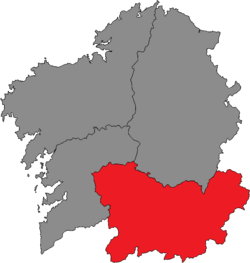Ourense (Parliament of Galicia constituency)
| Ourense | |
|---|---|
|
Parliament of Galicia Electoral Constituency |
|

Location of Ourense within Galicia
|
|
| Province | Ourense |
| Autonomous community | Galicia |
| Population | 318,391 (2016) |
| Electorate | 364,469 (2016) |
| Major settlements | Ourense |
| Current constituency | |
| Created | 1981 |
| Seats | 15 (1981–1997) 14 (1997–) |
| Member(s) | |
Ourense (Spanish: Orense) is one of the four constituencies (Spanish: circunscripciones) represented in the Parliament of Galicia, the regional legislature of the Autonomous Community of Galicia. The constituency currently elects 14 deputies. Its boundaries correspond to those of the Spanish province of Ourense. The electoral system uses the D'Hondt method and a closed-list proportional representation, with a minimum threshold of 5 percent.
The constituency was created as per the Statute of Autonomy for Galicia of 1981 and was first contested in the 1981 regional election. The Statute provided for the four provinces in Galicia—A Coruña, Lugo, Ourense and Pontevedra—to be established as multi-member districts in the Parliament of Galicia, with this regulation being maintained under the 1985 regional electoral law. Seats are allocated to constituencies, each entitled to an initial minimum of 10 seats, with the remaining 35 allocated among the constituencies in proportion to their populations. In the 1981 and 1985 elections, each constituency was allocated a fixed number of seats: 22 for A Coruña, 15 for Lugo, 15 for Ourense and 19 for Pontevedra.
Voting is on the basis of universal suffrage, which comprises all nationals over eighteen, registered in Galicia and in full enjoyment of their political rights. Amendments to the electoral law in 2011 required for Galicians abroad to apply for voting before being permitted to vote, a system known as "begged" or expat vote (Spanish: Voto rogado). Seats are elected using the D'Hondt method and a closed list proportional representation, with a threshold of 5 percent of valid votes—which includes blank ballots; until a 1993 reform, the threshold was set at 3 percent—being applied in each constituency. Parties not reaching the threshold are not taken into consideration for seat distribution. Additionally, the use of the D'Hondt method may result in an effective threshold over five percent, depending on the district magnitude.
...
Wikipedia
